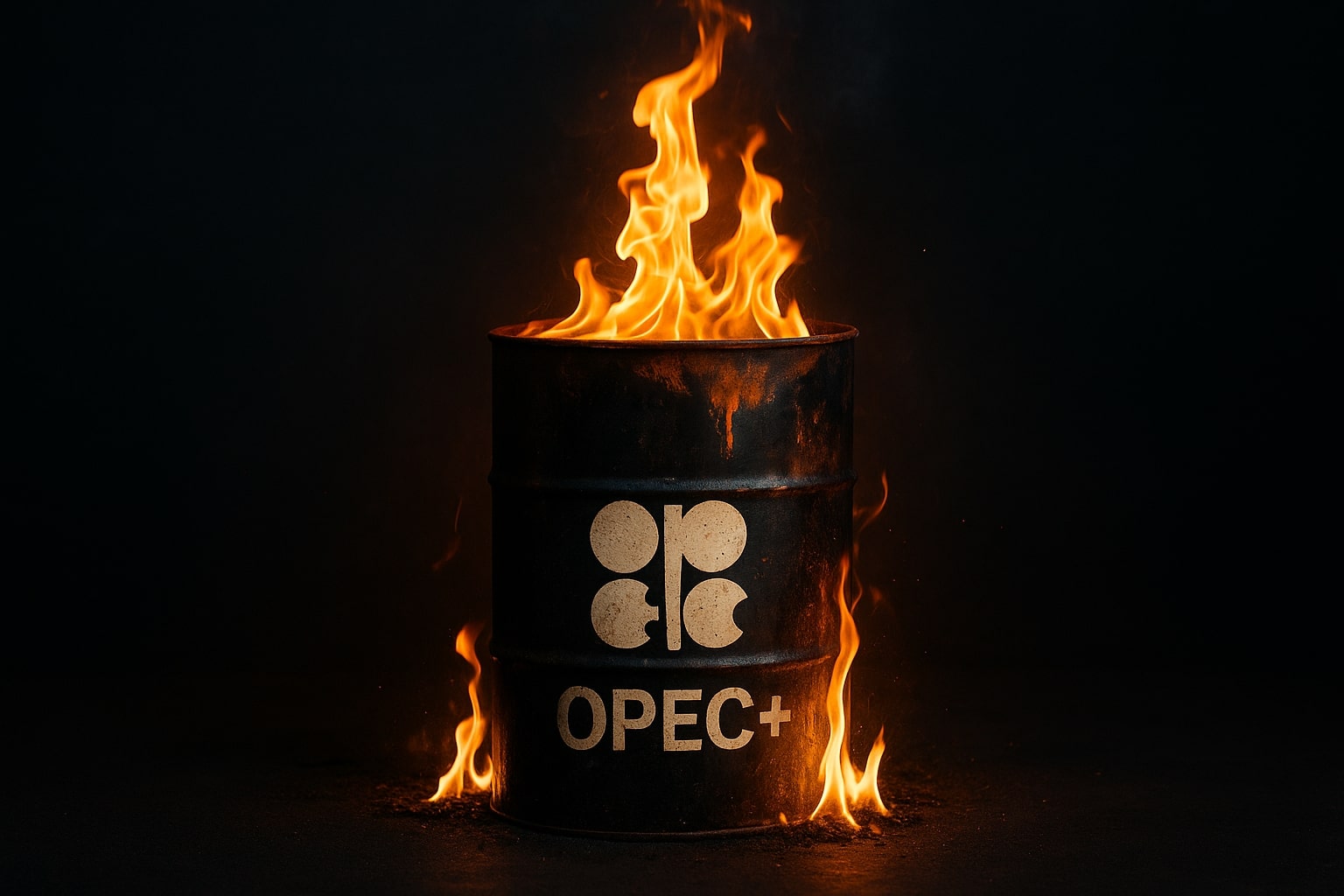Oil Price Dynamics Amid Global Tensions: Will OPEC+ and Market Shifts Determine the Next Move?
The global oil market is facing significant pressure as Brent crude (BZ=F) and West Texas Intermediate (WTI, CL=F) have both shown signs of weakness over the past week. As of May 23, 2025, Brent crude prices were hovering just above $64 per barrel, marking a 2% decline from earlier in the week. WTI, on the other hand, is trading just below $61 per barrel, which reflects a steady decline from previous highs. This comes amid growing concerns over an increase in oil production levels by OPEC+, as the group is reportedly considering raising daily output by 411,000 barrels starting in July. The decision to increase output follows a pattern of gradual relaxation of OPEC+ production cuts in recent months, which is now starting to weigh on global oil prices.
In addition to these supply-side concerns, a strengthening US dollar has added further bearish pressure on the price of crude oil. The passing of a major fiscal budget bill in the United States, which includes significant tax cuts and spending reductions, has driven the dollar higher. This, in turn, reduces demand for commodities like oil, as the stronger dollar makes crude more expensive for foreign buyers. The US oil market is also feeling the effects of rising crude oil inventories, with the latest reports showing a 1.3 million barrel increase in stockpiles, which typically signals weaker demand.
These developments have combined to push oil prices lower, but the picture is far from clear. Despite these short-term challenges, the broader picture indicates significant volatility ahead, with geopolitical factors, supply-side decisions, and global economic shifts all playing key roles in determining the future of oil prices.
OPEC+ Output Decisions and the Strain on Oil Prices
OPEC+, the alliance of oil-producing nations that includes members of the Organization of the Petroleum Exporting Countries (OPEC) and other major producers like Russia, has been a pivotal force in shaping the global oil market. As the group considers increasing its output by another 411,000 barrels per day in July, traders are bracing for what could be a significant shift in the market balance. Since OPEC+ began relaxing its output restrictions earlier this year, the market has been flooded with additional supply, which has exerted downward pressure on prices. In the context of an already fragile global economy and growing geopolitical tensions, this decision could result in even more bearish sentiment in the near term.
The most recent surge in US crude oil inventories adds fuel to the fire. According to the latest data from the Energy Information Administration (EIA), commercial oil stocks in the US climbed by 1.3 million barrels, which contributes to concerns about an oversupply in the market. The implications of this are significant for the price of WTI (CL=F) and Brent crude (BZ=F), as rising stockpiles often signal weaker demand and excess supply. This uptick in storage demand reflects mounting anxieties over the ongoing market dynamics, particularly as traders anticipate further production increases from OPEC+.
Looking ahead, the decision on whether OPEC+ will implement this planned output increase remains a crucial point of focus. As analysts like Warren Patterson from ING Groep NV point out, if OPEC+ moves forward with a larger increase in output, it could shift the group's strategy from attempting to defend prices to defending market share. This shift could have far-reaching consequences for both short-term price volatility and long-term market stability.
Geopolitical Tensions and Their Impact on Oil Markets
In addition to supply-side issues, geopolitical tensions have also played a crucial role in shaping the price of oil. The recent reports of potential military strikes on Iranian nuclear facilities by Israel have created short-term price spikes, although these gains were fleeting. Oil traders are keenly aware of the risks that geopolitical instability poses to the oil market, especially in the Middle East, where major oil producers like Saudi Arabia and Iran hold substantial influence.
Meanwhile, the ongoing situation with Russia continues to cast a shadow over oil markets. The European Union has proposed lowering the cap on Russian oil prices to $50 per barrel, a move that is designed to further punish Russia for its actions in Ukraine. However, US officials are skeptical about this approach, arguing that market forces are already doing enough to lower Russian oil revenues. Despite the political maneuvering, the current $60 per barrel cap remains in place, and it’s unlikely to change anytime soon. For now, the impact of these sanctions remains relatively muted, as the cap has not yet significantly hurt Russian oil production.
The Shift in Global Oil Demand: China vs. India
A significant shift in global oil demand is underway, with China’s once-dominant role as the world’s largest oil consumer beginning to wane. According to a recent report by Moody’s Investors Service, China’s crude oil demand is expected to plateau within the next 3-5 years, driven by factors such as slowing economic growth, a shrinking population, and a rapid transition to electric vehicles (EVs). This change in demand dynamics could have a profound impact on global oil prices, especially as India steps into the role of the world’s leading oil demand driver.
India’s oil consumption is expected to rise sharply in the coming years, with the International Energy Agency (IEA) projecting that the country’s oil demand will increase from 5 million barrels per day (bpd) in 2023 to over 6.5 million bpd by 2030. This shift in demand from China to India represents a fundamental change in the global oil market, as India’s growing population, expanding infrastructure, and rising per capita consumption make it a key player in global oil markets.
For exporters like Saudi Arabia and Russia, India is quickly becoming the market to watch. While China remains a major player in global oil trade, its decreasing demand growth may force producers to recalibrate their strategies and look to India as the next growth engine for oil consumption.
Oil Price Outlook: What’s Next for WTI and Brent Crude?
With OPEC+ deliberating over whether to increase production and global economic factors continuing to weigh on the market, the outlook for oil prices is highly uncertain. Brent crude (BZ=F) and WTI (CL=F) prices are currently sitting near $64 and $60, respectively, down approximately 2% from earlier in the week. However, with rising US crude oil inventories, increasing production levels, and geopolitical tensions adding volatility to the mix, the future of oil prices remains in flux.
As of now, the market is still processing the ramifications of the recent US fiscal policies, OPEC+ output discussions, and geopolitical events, all of which contribute to the complex dynamics that drive oil prices. For investors, keeping a close eye on these factors will be essential in understanding where oil prices are headed in the coming weeks.
WTI and Brent Crude in Focus
Looking at the future, Brent crude (BZ=F) and WTI (CL=F) remain at critical junctures, with potential for further declines depending on the OPEC+ decision and global demand shifts. The coming weeks will likely see increased volatility as market participants react to announcements from OPEC+ and track the ongoing geopolitical developments. Oil prices have already shed about 14% this year, reaching their lowest levels since 2021, but the market remains responsive to any changes in global production, demand, and supply-side policies.
The question remains: Will OPEC+ succeed in balancing its production increase with global demand? As we move closer to July, when the next OPEC+ meeting is scheduled, traders and investors will need to carefully navigate these uncertain waters, closely monitoring key developments in global oil politics, production, and economic growth forecasts.




















